Winter Wheat Seeding Decisions for Improved Grain Yield and Yield Components
Abstract
1. Introduction
2. Materials and Methods
3. Results and Discussion
3.1. Grain Yield
3.2. Biomass
3.3. 1000-Kernel Weight
3.4. Tillers
4. Conclusions
Author Contributions
Funding
Data Availability Statement
Conflicts of Interest
References
- Fowler, D.B. Wheat production in the high winter stress climate of the Great Plains of North America—An experiment in crop adaptation. Crop Sci. 2012, 52, 11–20. [Google Scholar] [CrossRef]
- Cao, P.; Lu, C.; Yu, Z. Historical nitrogen fertilizer use in agricultural ecosystems of the contiguous United States during 1850–2015: Application rate, timing, and fertilizer types. Earth Syst. Sci. Data 2018, 10, 969–984. [Google Scholar] [CrossRef]
- Bailey-Serres, J.; Parker, J.E.; Ainsworth, E.A.; Oldroyd, G.E.; Schroeder, J.I. Genetic strategies for improving crop yields. Nature 2019, 575, 109–118. [Google Scholar] [CrossRef] [PubMed]
- Maeoka, R.E.; Sadras, V.O.; Ciampitti, I.A.; Diaz, D.R.; Fritz, A.K.; Lollato, R.P. Changes in the phenotype of winter wheat varieties released between 1920 and 2016 in response to in-furrow fertilizer: Biomass allocation, yield, and grain protein concentration. Front. Plant Sci. 2020, 10, 1786. [Google Scholar] [CrossRef] [PubMed]
- Darwinkel, A.; Ten Hag, B.; Kuizenga, J. Effect of sowing date and seed rate on crop development and grain production of winter wheat. Neth. J. Agric. Sci. 1977, 25, 83–94. [Google Scholar] [CrossRef]
- Blue, E.; Mason, S.; Sander, D. Influence of planting date, seeding rate, and phosphorus rate on wheat yield. Agron. J. 1990, 82, 762–768. [Google Scholar] [CrossRef]
- Geleta, B.; Atak, M.; Baenziger, P.; Nelson, L.; Baltenesperger, D.; Eskridge, K.; Shipman, M.; Shelton, D. Seeding rate and genotype effect on agronomic performance and end-use quality of winter wheat. Crop Sci. 2002, 42, 827–832. [Google Scholar] [CrossRef]
- Dong, S.; Zhang, X.; Chu, J.; Zheng, F.; Fei, L.; Dai, X.; He, M. Optimised seeding rate and nitrogen topdressing ratio for simultaneous improvement of grain yield and bread-making quality in bread wheat sown on different dates. J. Sci. Food Agric. 2021, 102, 360–369. [Google Scholar] [CrossRef]
- Anderson, W.; Johansen, C.; Siddique, K.H. Addressing the yield gap in rainfed crops: A review. Agron. Sustain. Dev. 2016, 36, 18. [Google Scholar] [CrossRef]
- Lindsey, L.E.; Goodwin, A.W.; Harrison, S.K.; Paul, P.A. Optimum seeding rate and stand assessment of soft red winter wheat. Agron. J. 2020, 112, 4069–4075. [Google Scholar] [CrossRef]
- Dai, X.; Xiao, L.; Jia, D.; Kong, H.; Wang, Y.; Li, C.; Zhang, Y.; He, M. Increased plant density of winter wheat can enhance nitrogen–uptake from deep soil. Plant Soil 2014, 384, 141–152. [Google Scholar] [CrossRef]
- Valério, I.P.; De Carvalho, F.I.F.; Benin, G.; Da Silveira, G.; Da Silva, J.A.G.; Nornberg, R.; Hagemann, T.; Luche, H.D.S.; De Oliveira, A.C. Seeding density in wheat: The more, the merrier? Sci. Agric. 2013, 70, 176–184. [Google Scholar] [CrossRef]
- Bastos, L.M.; Carciochi, W.; Lollato, R.P.; Jaenisch, B.R.; Rezende, C.R.; Schwalbert, R.; Vara Prasad, P.; Zhang, G.; Fritz, A.K.; Foster, C. Winter wheat yield response to plant density as a function of yield environment and tillering potential: A review and field studies. Front. Plant Sci. 2020, 11, 54. [Google Scholar] [CrossRef] [PubMed]
- Khan, A.; Ahmad, A.; Ali, W.; Hussain, S.; Ajayo, B.S.; Raza, M.A.; Kamran, M.; Te, X.; Al Amin, N.; Ali, S. Optimization of plant density and nitrogen regimes to mitigate lodging risk in wheat. Agron. J. 2020, 112, 2535–2551. [Google Scholar] [CrossRef]
- Van Es, H.; Kay, B.; Melkonian, J.; Sogbedji, J.; Bruulsma, T. Nitrogen management for maize in humid regions: Case for a dynamic modeling approach. In Managing Crop Nitrogen for Weather: Proceedings of the Symposium “Integrating Weather Variability into Nitrogen Recommendations; Citeseer: Indianapolis, IN, USA, 2006. [Google Scholar]
- Hunt, J.R.; Lilley, J.M.; Trevaskis, B.; Flohr, B.M.; Peake, A.; Fletcher, A.; Zwart, A.B.; Gobbett, D.; Kirkegaard, J.A. Early sowing systems can boost Australian wheat yields despite recent climate change. Nat. Clim. Change 2019, 9, 244–247. [Google Scholar] [CrossRef]
- Cho, K.; Falloon, P.; Gornall, J.; Betts, R.; Clark, R. Winter wheat yields in the UK: Uncertainties in climate and management impacts. Clim. Res. 2012, 54, 49–68. [Google Scholar] [CrossRef]
- Dai, X.; Wang, Y.; Dong, X.; Qian, T.; Yin, L.; Dong, S.; Chu, J.; He, M. Delayed sowing can increase lodging resistance while maintaining grain yield and nitrogen use efficiency in winter wheat. Crop J. 2017, 5, 541–552. [Google Scholar] [CrossRef]
- Ding, D.; Feng, H.; Zhao, Y.; He, J.; Zou, Y.; Jin, J. Modifying winter wheat sowing date as an adaptation to climate change on the Loess Plateau. Agron. J. 2016, 108, 53–63. [Google Scholar] [CrossRef]
- The University of Nebraska. Winter Wheat Variety Characteristics. 2015. Available online: https://cropwatch.unl.edu/documents/2015%20wheat%20variety%20characteristics.pdf (accessed on 24 December 2021).
- Bhatta, M.; Eskridge, K.M.; Rose, D.J.; Santra, D.K.; Baenziger, P.S.; Regassa, T. Seeding rate, genotype, and topdressed nitrogen effects on yield and agronomic characteristics of winter wheat. Crop Sci. 2017, 57, 951–963. [Google Scholar] [CrossRef]
- Bhatta, M.; Regassa, T.; Rose, D.J.; Baenziger, P.S.; Eskridge, K.M.; Santra, D.K.; Poudel, R. Genotype, environment, seeding rate, and top-dressed nitrogen effects on end-use quality of modern Nebraska winter wheat. J. Sci. Food Agric. 2017, 97, 5311–5318. [Google Scholar] [CrossRef]
- Eltaher, S.; Baenziger, P.S.; Belamkar, V.; Emara, H.A.; Nower, A.A.; Salem, K.F.; Alqudah, A.M.; Sallam, A. GWAS revealed effect of genotype× environment interactions for grain yield of Nebraska winter wheat. BMC Genom. 2021, 22, 2. [Google Scholar] [CrossRef] [PubMed]
- Paymard, P.; Bannayan, M.; Haghighi, R.S. Analysis of the climate change effect on wheat production systems and investigate the potential of management strategies. Nat. Hazards 2018, 91, 1237–1255. [Google Scholar] [CrossRef]
- Weiss, A.; Hays, C.J.; Won, J. Assessing winter wheat responses to climate change scenarios: A simulation study in the US Great Plains. Clim. Chang. 2003, 58, 119–147. [Google Scholar] [CrossRef]
- Tapley, M.; Ortiz, B.V.; van Santen, E.; Balkcom, K.S.; Mask, P.; Weaver, D.B. Location, seeding date, and variety interactions on winter wheat yield in southeastern United States. Agron. J. 2013, 105, 509–518. [Google Scholar] [CrossRef]
- Montgomery, D.C. Design and Analysis of Experiments, 8th ed.; John wiley & sons: Hoboken, NJ, USA, 2013. [Google Scholar]
- SAS Institute. The SAS system for Windows; SAS Institute: Cary, NC, USA, 2020. [Google Scholar]
- R Core Team. R: A Language and Environment for Statistical Computing; R Foundation for Statistical Computing: Vienna, Austria, 2022. [Google Scholar]
- Wickham, H.; Averick, M.; Bryan, J.; Chang, W.; McGowan, L.D.A.; François, R.; Grolemund, G.; Hayes, A.; Henry, L.; Hester, J.; et al. Welcome to the tidyverse. J. Open Source Softw. 2019, 4, 1686. [Google Scholar] [CrossRef]
- Fahad, S.; Hussain, S.; Chauhan, B.S.; Saud, S.; Wu, C.; Hassan, S.; Tanveer, M.; Jan, A.; Huang, J. Weed growth and crop yield loss in wheat as influenced by row spacing and weed emergence times. Crop Prot. 2015, 71, 101–108. [Google Scholar] [CrossRef]
- Chen, C.; Neill, K.; Wichman, D.; Westcott, M. Hard red spring wheat response to row spacing, seeding rate, and nitrogen. Agron. J. 2008, 100, 1296–1302. [Google Scholar] [CrossRef]
- Frederick, J.; Marshall, H. Grain yield and yield components of soft red winter wheat as affected by management practices 1. Agron. J. 1985, 77, 495–499. [Google Scholar] [CrossRef]
- Sacks, W.J.; Deryng, D.; Foley, J.A.; Ramankutty, N. Crop planting dates: An analysis of global patterns. Glob. Ecol. Biogeogr. 2010, 19, 607–620. [Google Scholar] [CrossRef]
- Shah, S.; Harrison, S.; Boquet, D.; Colyer, P.; Moore, S. Management effects on yield and yield components of late-planted wheat. Crop Sci. 1994, 34, 1298–1303. [Google Scholar] [CrossRef]
- Dahlke, B.; Oplinger, E.; Gaska, J.; Martinka, M. Influence of planting date and seeding rate on winter wheat grain yield and yield components. J. Prod. Agric. 1993, 6, 408–414. [Google Scholar] [CrossRef]
- Shah, F.; Coulter, J.A.; Ye, C.; Wu, W. Yield penalty due to delayed sowing of winter wheat and the mitigatory role of increased seeding rate. Eur. J. Agron. 2020, 119, 126120. [Google Scholar] [CrossRef]
- Baloch, D.; Karow, R.; Marx, E.; Kling, J.; Witt, M. Vernalization studies with Pacific Northwest wheat. Agron. J. 2003, 95, 1201–1208. [Google Scholar] [CrossRef]
- May, W.E.; Aldous, L.; Lafond, G.P. Feasibility of a wider row spacing and recommended nitrogen in no-till wheat. Agron. J. 2020, 112, 4076–4091. [Google Scholar] [CrossRef]
- van der Meulen, A.; Chauhan, B.S. A review of weed management in wheat using crop competition. Crop Prot. 2017, 95, 38–44. [Google Scholar] [CrossRef]
- Chen, S.; Zhang, X.; Sun, H.; Ren, T.; Wang, Y. Effects of winter wheat row spacing on evapotranpsiration, grain yield and water use efficiency. Agric. Water Manag. 2010, 97, 1126–1132. [Google Scholar] [CrossRef]
- Donaldson, E.; Schillinger, W.F.; Dofing, S.M. Straw production and grain yield relationships in winter wheat. Crop Sci. 2001, 41, 100–106. [Google Scholar] [CrossRef]
- Thiry, D.; Sears, R.G.; Shroyer, J.P.; Paulsen, G.M. Planting Date Effects on Tiller Development and Productivity of Wheat. 2002. Available online: https://krex.k-state.edu/dspace/bitstream/handle/2097/16369/SRL133.pdf?sequence=1 (accessed on 29 November 2022).
- Shahzad, K.; Bakht, J.; Shah, W.A.; Shafi, M.; Jabeen, N. Yield and yield components of various wheat cultivars as affected by different sowing dates. Asian J. Plant Sci. 2002, 1, 522–525. [Google Scholar] [CrossRef][Green Version]
- Ruza, A.; Bankina, B.; Strikauska, S. The impact of sowing time on sugar content and snow mould development in winter wheat. Acta Biol. Univ. Daugavp. 2011, 11, 88–95. [Google Scholar]
- Liu, K.; Zhang, C.; Guan, B.; Yang, R.; Liu, K.; Wang, Z.; Li, X.; Xue, K.; Yin, L.; Wang, X. The effect of different sowing dates on dry matter and nitrogen dynamics for winter wheat: An experimental simulation study. PeerJ 2021, 9, e11700. [Google Scholar] [CrossRef]
- Wang, Z.; Khan, S.; Sun, M.; Ren, A.; Lin, W.; Ding, P.; Noor, H.; Yu, S.; Feng, Y.; Wang, Q. Optimizing the Wheat Seeding Rate for Wide-Space Sowing to Improve Yield and Water and Nitrogen Utilization. Int. J. Plant Prod. 2021, 15, 553–562. [Google Scholar] [CrossRef]
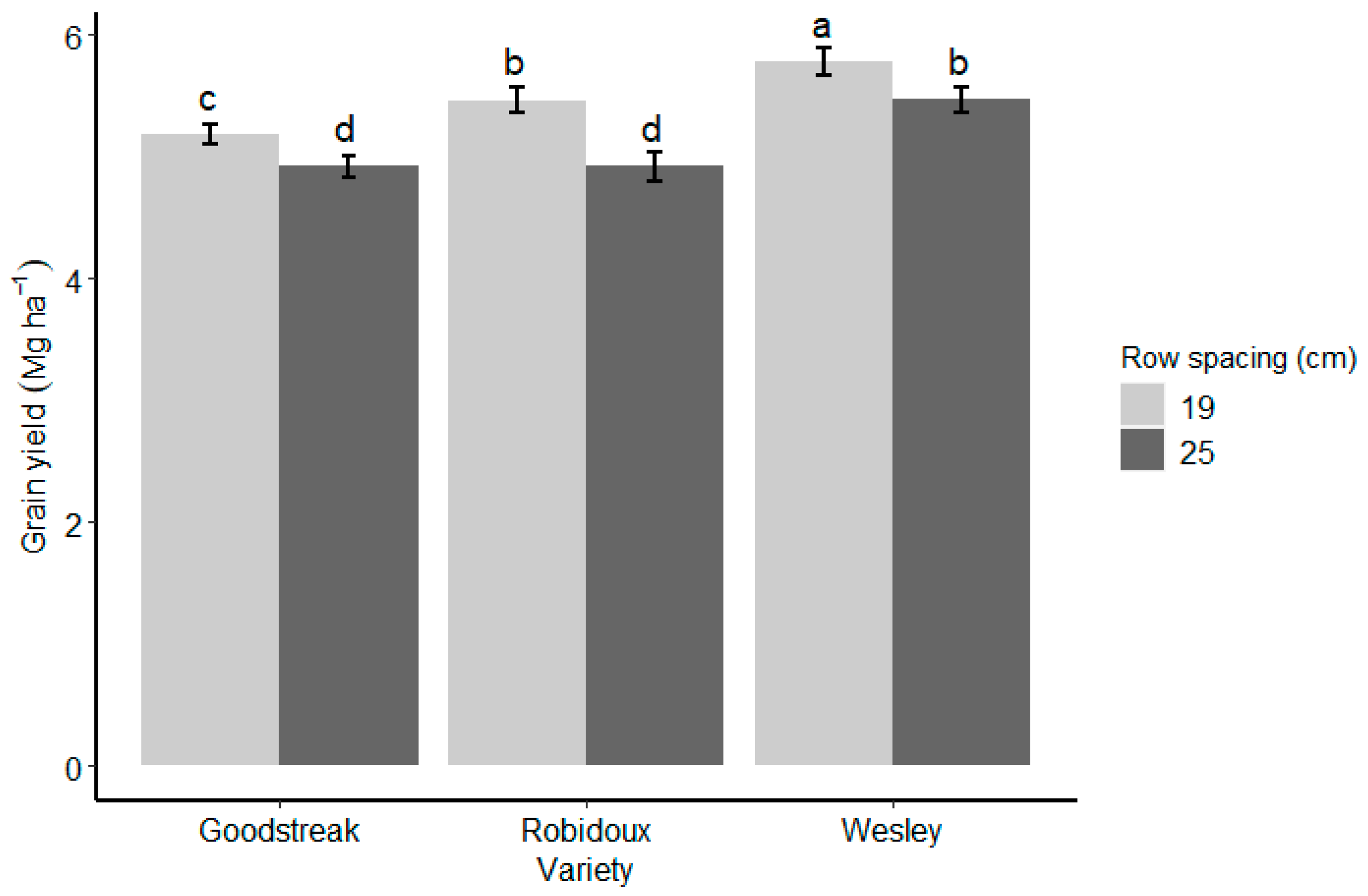
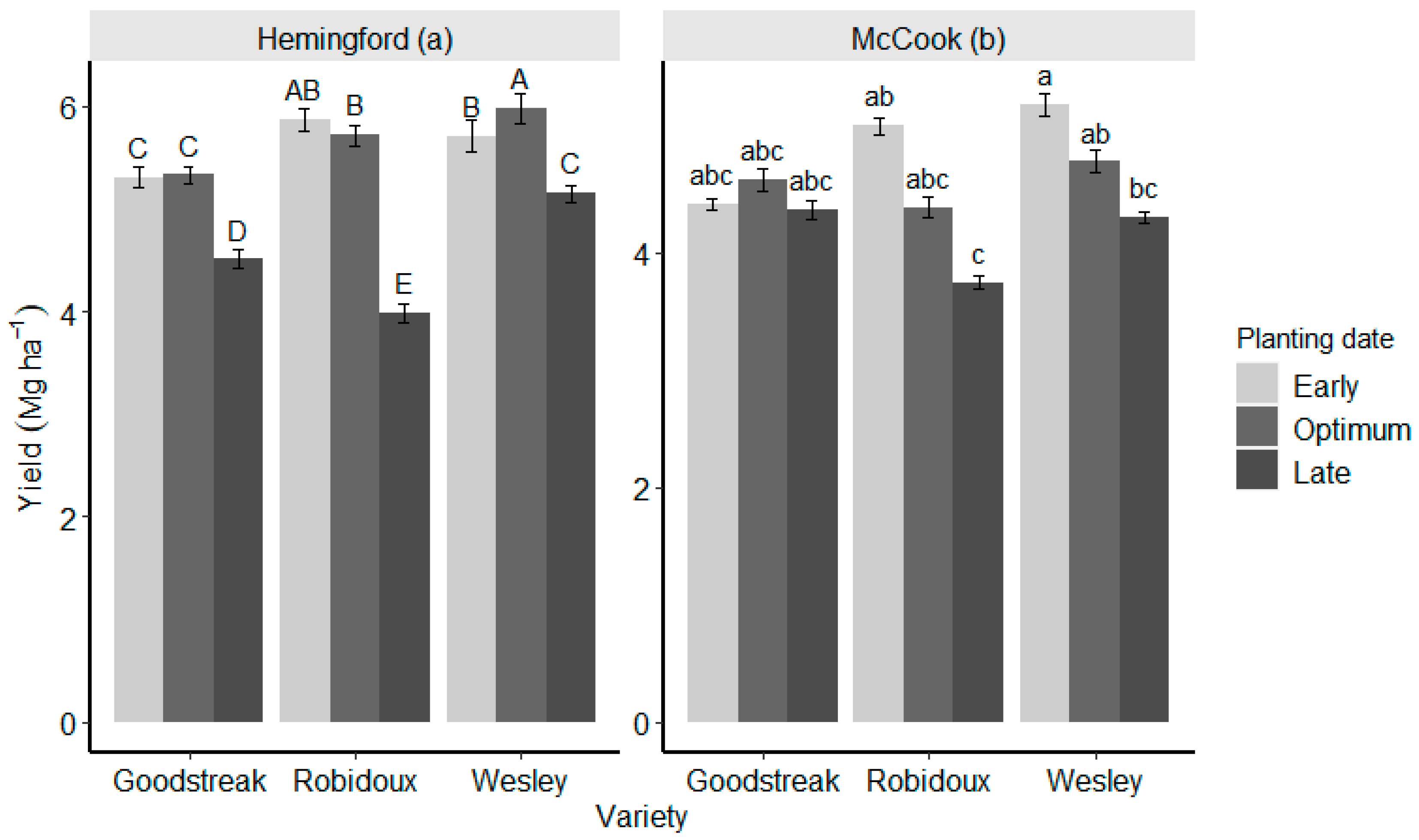
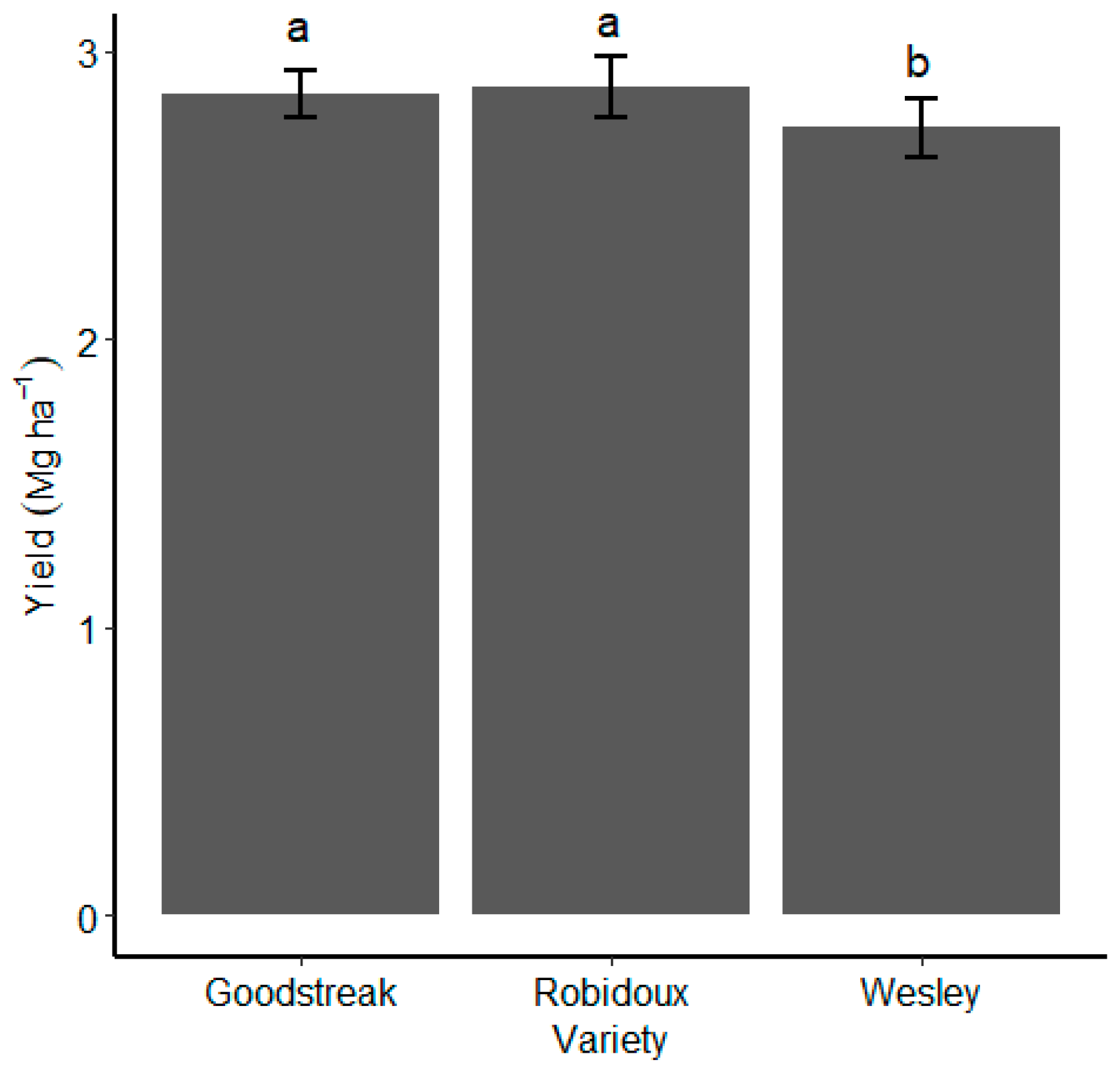
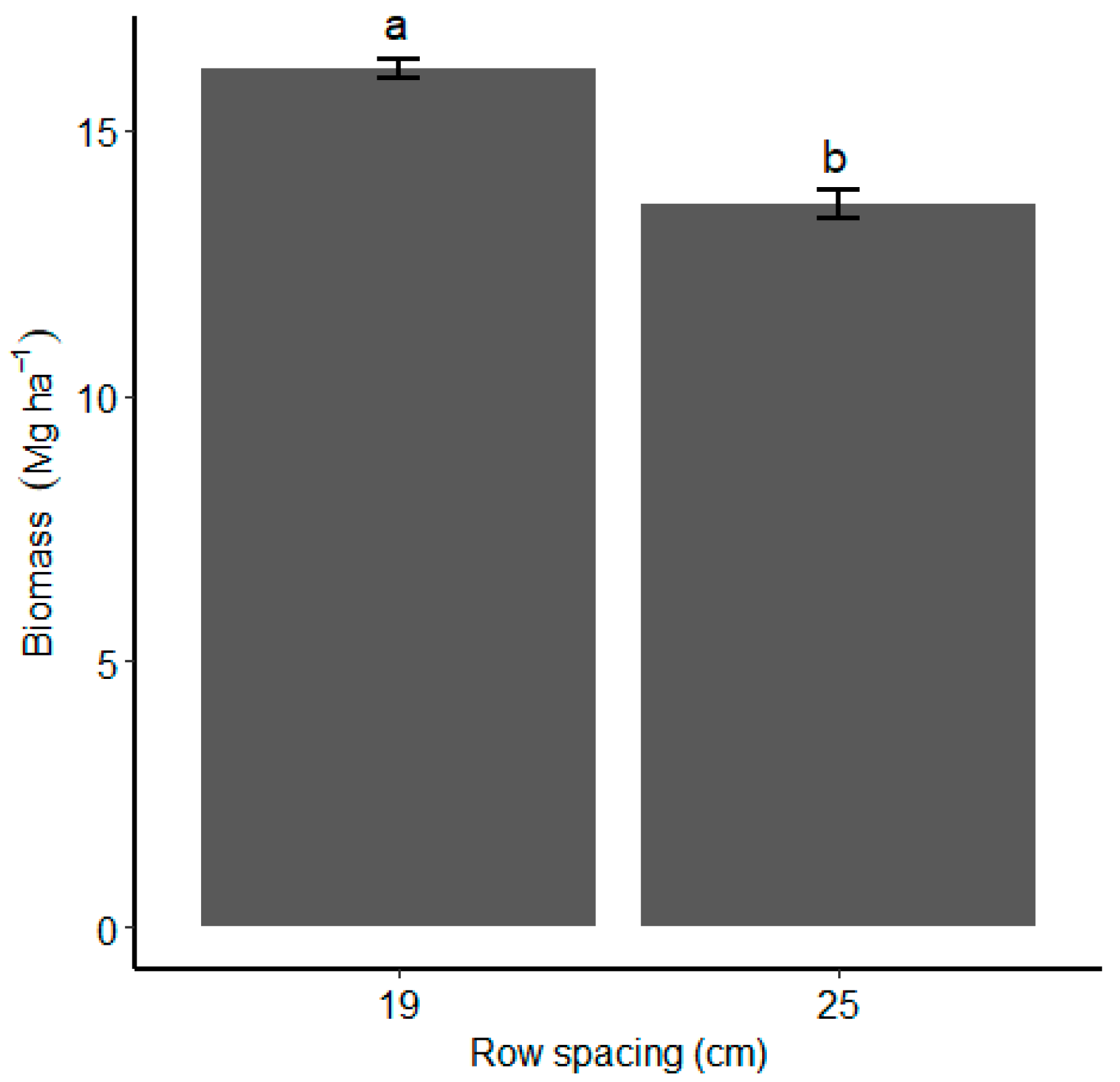
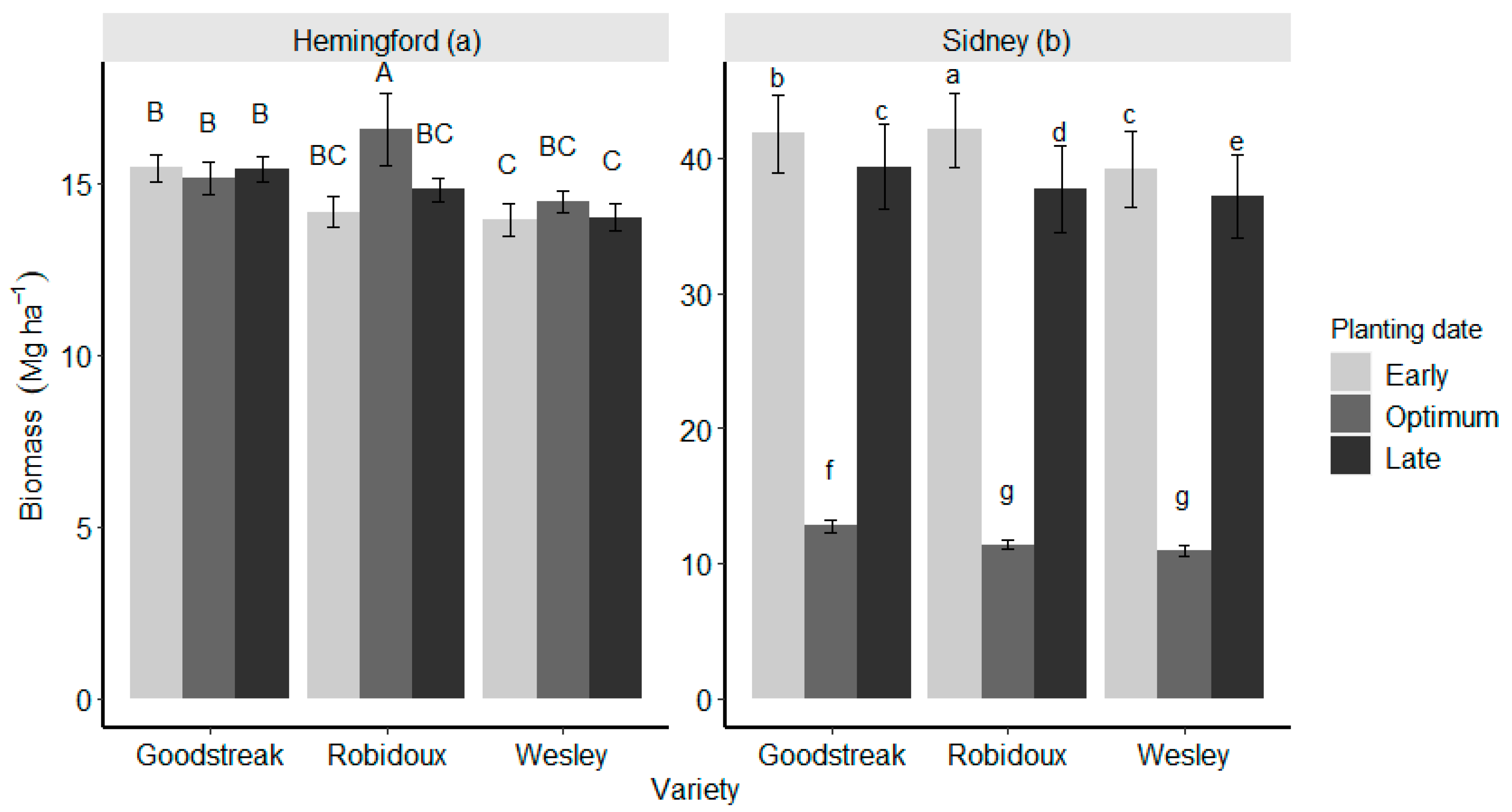
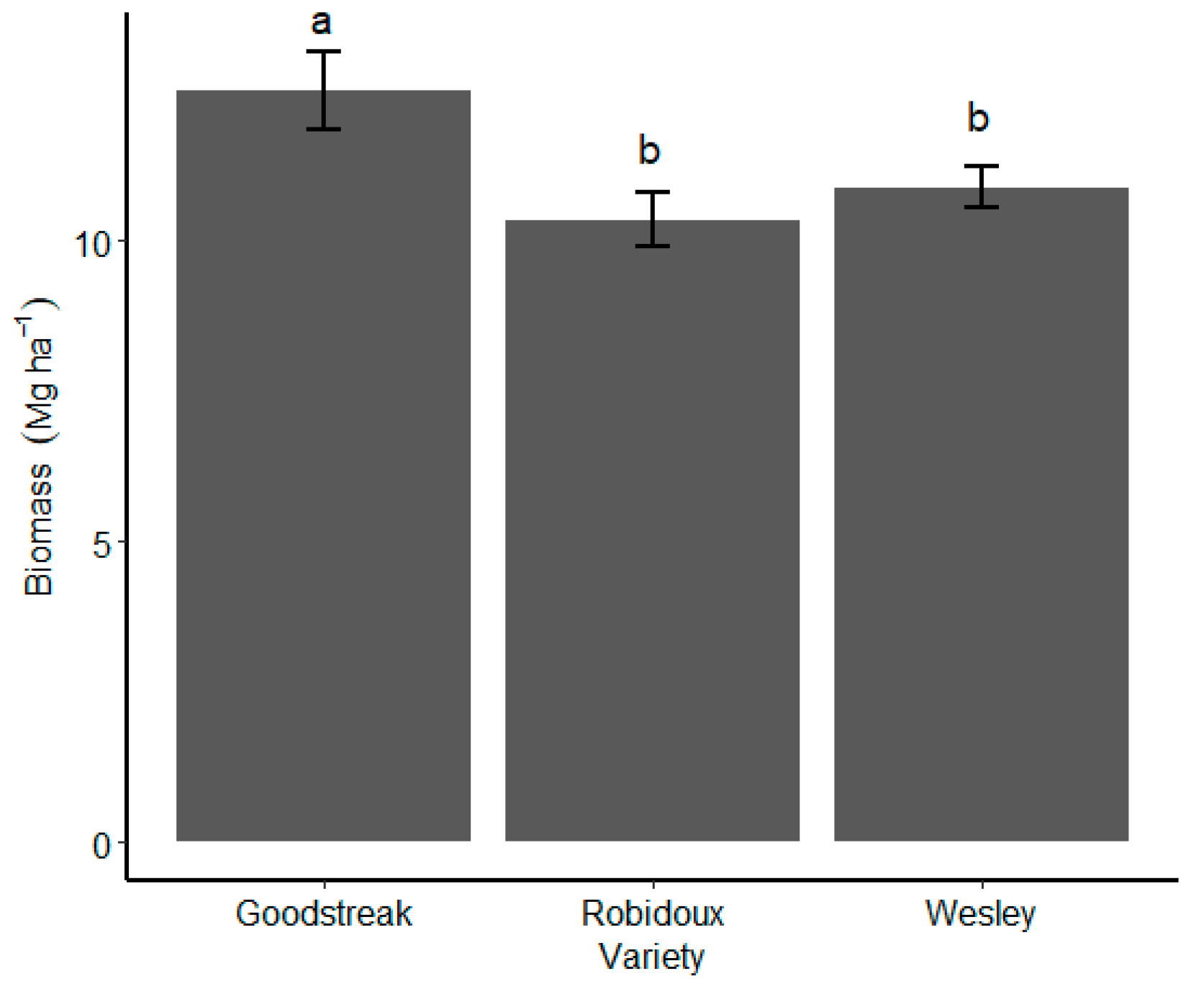
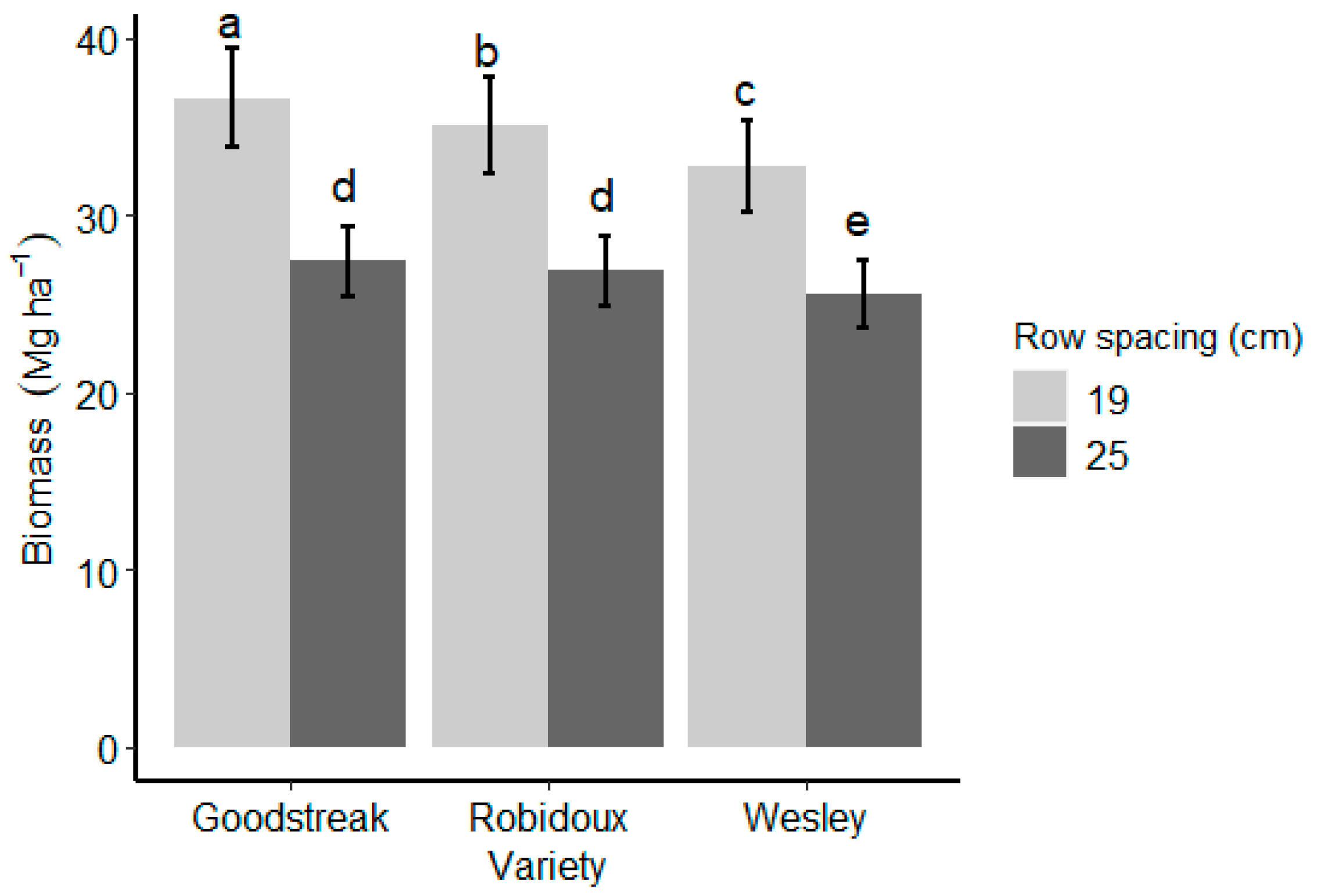
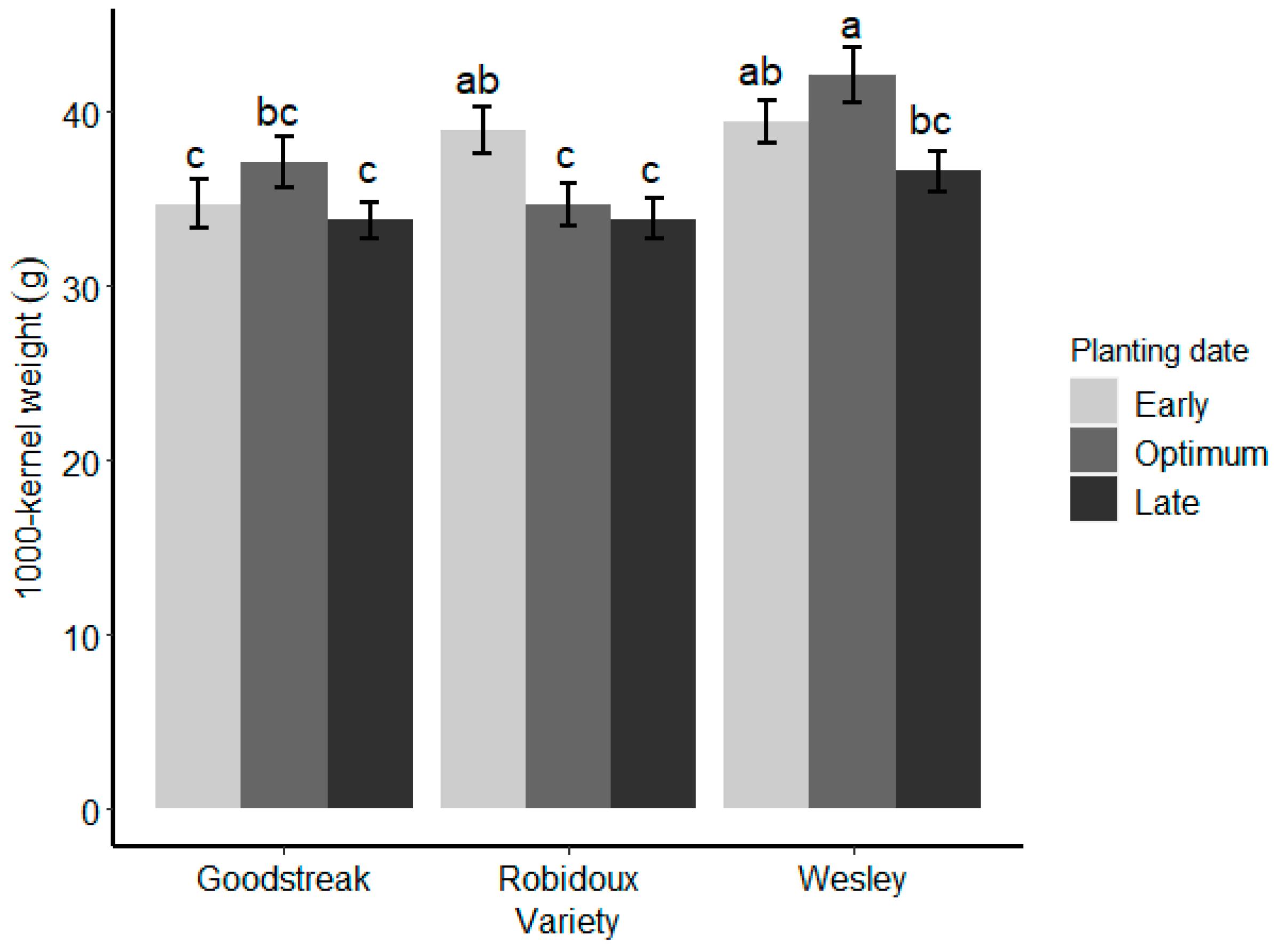
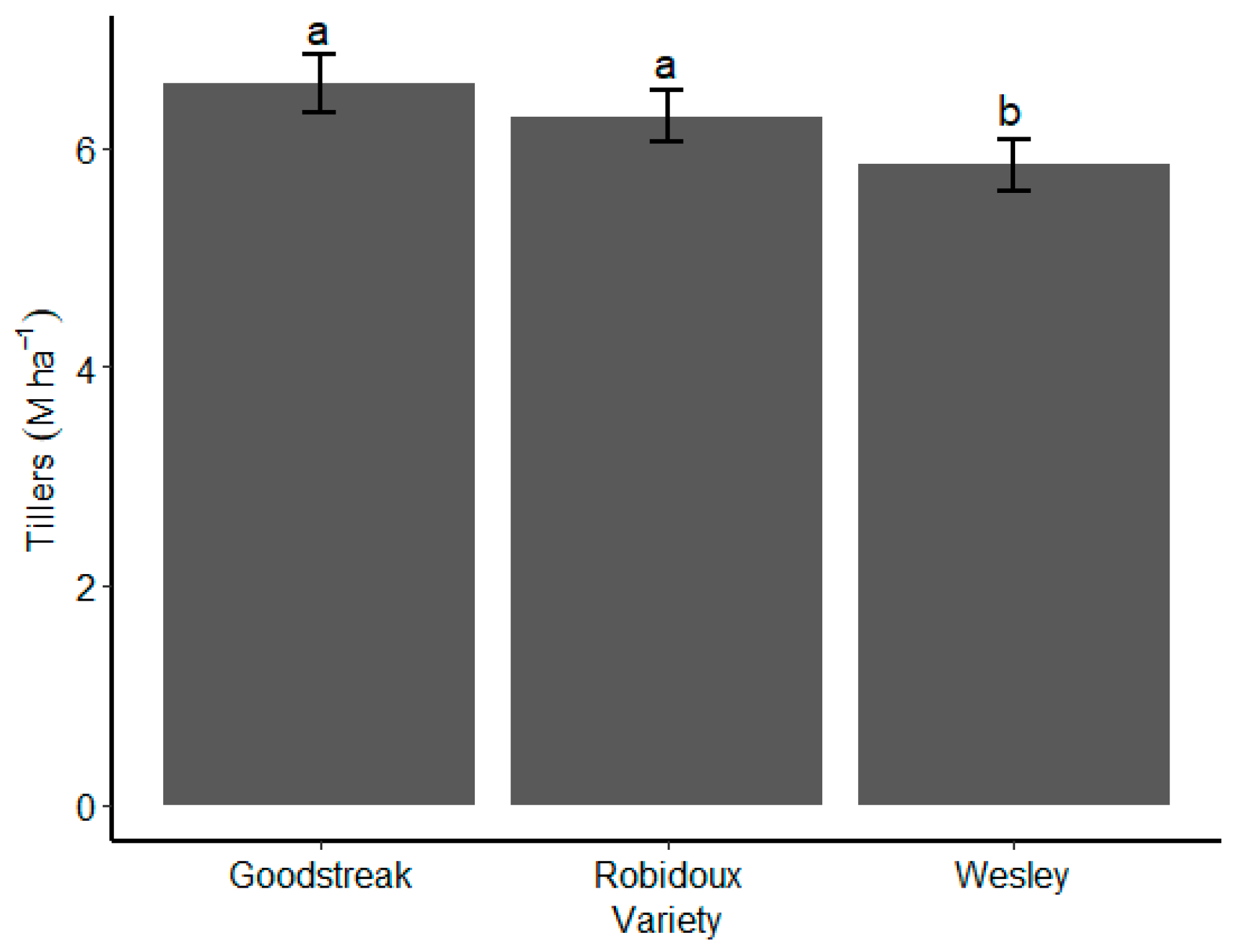
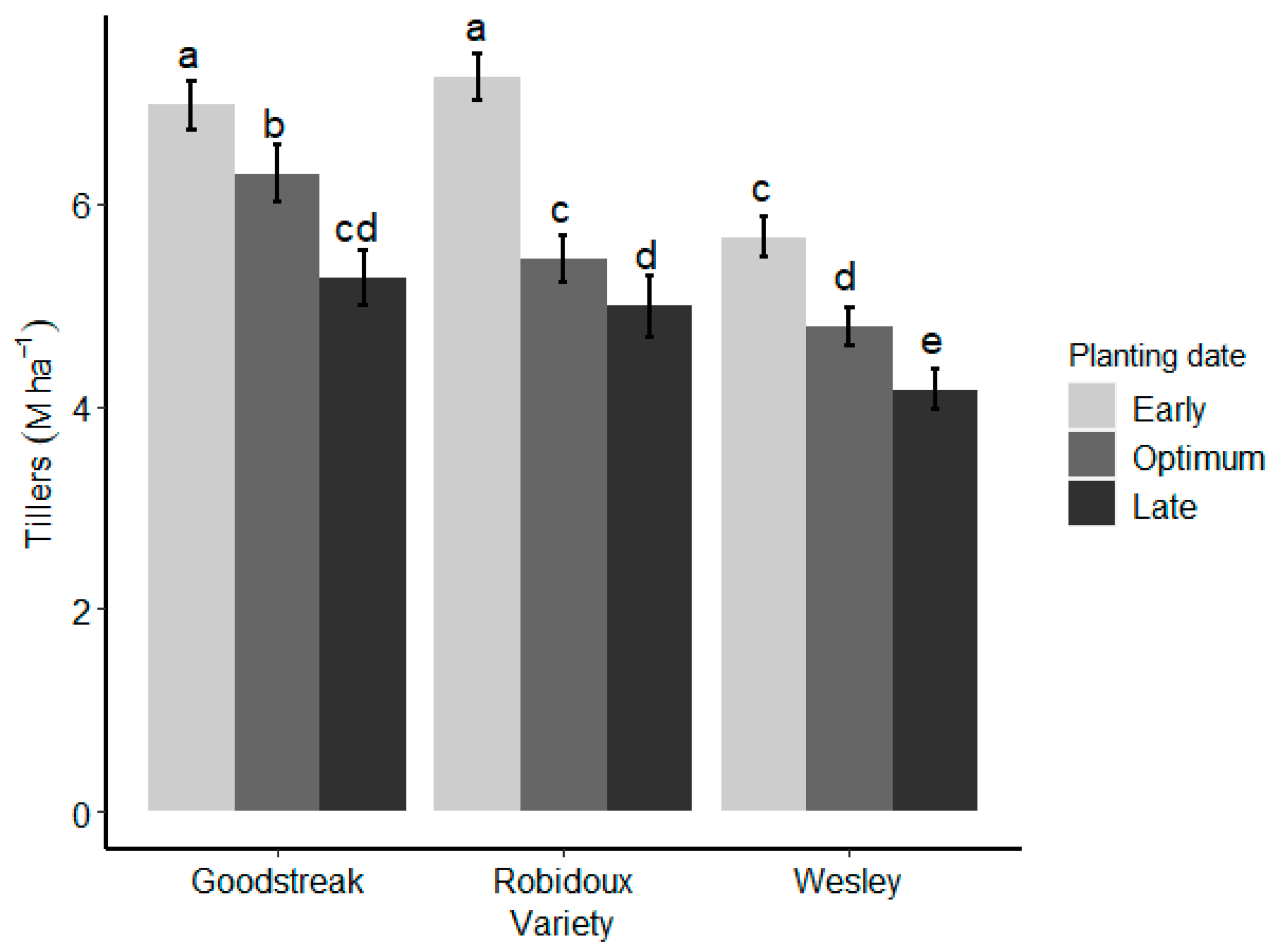
| Site | Planting Date | ||
|---|---|---|---|
| Early | Optimum | Late | |
| Sidney | 29 August 2018 | 10 September 2018 | 24 September 2018 |
| 25 August 2017 | 12 September 2017 | 3 October 2017 | |
| Hemingford | 30 August 2018 | 11 September 2018 | 4 October 2018 |
| 31 August 2017 | 12 September 2017 | 4 October 2017 | |
| McCook | 5 September 2018 | 21 September 2018 | 23 October 2018 |
| 18 September 2017 | 2 October 2017 | 18 October 2017 |
| Effect | Hemingford | McCook | Sidney | |
|---|---|---|---|---|
| Num df | p-values | |||
| PD 1 | 2 | NS | NS | NS |
| RS 2 | 1 | 0.0099 | NS | NS |
| SR 3 (RS) | 3 | NS | NS | NS |
| V 4 | 2 | <0.00001 | <0.0001 | 0.02 |
| PD × RS | 2 | NS | NS | NS |
| PD × SR | 6 | 0.016 | NS | NS |
| PD × V | 4 | <0.0001 | <0.0001 | NS |
| RS × V | 2 | 0.0135 | NS | NS |
| SR × V | 6 | NS | NS | NS |
| PD × RS × V | 4 | NS | NS | NS |
| PD × SR(RS) × V | 36 | NS | NS | NS |
| Main Effect Level | Hemingford | McCook | Sidney | |
|---|---|---|---|---|
| Mean ± SE | ||||
| Planting Date | ||||
| Early | 5631 ± 753 | 4917 ± 330 | 3461 ± 1126 | |
| On-Time | 5679 ± 753 | 4606 ± 330 | 3008 ± 1126 | |
| Late | 4548 ± 753 | 4141 ± 330 | 1999 ± 1126 | |
| Row Spacing | ||||
| 19 cm | 5469 ± 436 a | 4781 ± 214 | 2930 ± 659 | |
| 25 cm | 5103 ± 436 b | 5328 ± 214 | 2715 ± 659 | |
| Seed Rate (Row Spacing) | ||||
| 19 cm Row Spacing | 2.4 seeds ha−1 | 5354 ± 439 bc | 4584 ± 219 bc | 2868 ± 661 |
| 2.8 seeds ha−1 | 5431 ± 439 ab | 4713 ± 219 b | 2927 ± 661 | |
| 3.1 seeds ha−1 | 5505 ± 439 ab | 4884 ± 219 a | 2972 ± 661 | |
| 3.4 seeds ha−1 | 5584 ± 439 a | 4940 ± 219 a | 2953 ± 661 | |
| 25 cm Row Spacing | 1.8 seeds ha−1 | 5016 ± 439 d | 4220 ± 220 c | 2641 ± 661 |
| 2.1 seeds ha−1 | 5072 ± 439 d | 4267 ± 219 c | 2763 ± 661 | |
| 2.3 seeds ha−1 | 5146 ± 439 d | 4368 ± 219 bc | 2719 ± 661 | |
| 2.6 seeds ha−1 | 5179 ± 439 cd | 4458 ± 219 bc | 2736 ± 661 | |
| Variety | ||||
| Goodstreak | 5052 ± 436 c | 4468 ± 197 b | 2867 ± 654 a | |
| Robidoux | 5190 ± 436 b | 4410 ± 197 b | 2867 ± 654 a | |
| Wesley | 5616 ± 436 a | 4786 ± 197 a | 2734 ± 654 b | |
| Effect | Num df | Biomass | 1000-Kernel Weight | Tillers | ||||||
|---|---|---|---|---|---|---|---|---|---|---|
| HEM | MC | SID | HEM | MC | SID | HEM | MC | SID | ||
| p-Values and Significance Levels | ||||||||||
| PD 1 | 2 | NS | NS | NS | NS | NS | NS | NS | NS | NS |
| RS 2 | 1 | 0.0039 | NS | NS | NS | NS | NS | NS | NS | 0.03 |
| SR 3 (RS) | 3 | NS | 0.0436 | NS | NS | NS | NS | NS | NS | NS |
| V 4 | 2 | 0.003 | 0.0029 | <0.0001 | NS | <0.0001 | NS | 0.0003 | <0.0001 | <0.0001 |
| PD × RS | 2 | NS | NS | NS | NS | NS | NS | NS | NS | NS |
| PD × SR(RS) | 6 | NS | NS | NS | NS | NS | NS | NS | NS | NS |
| PD × V | 4 | 0.0417 | NS | <0.0001 | NS | 0.0263 | NS | NS | NS | 0.0055 |
| RS × V | 2 | NS | NS | 0.0291 | NS | NS | NS | NS | NS | 0.0034 |
| V × SR(RS) | 6 | NS | NS | NS | NS | NS | NS | NS | NS | NS |
| PD × RS × V | 4 | NS | NS | NS | NS | NS | NS | NS | NS | NS |
| PD × V × SR(RS) | 36 | NS | NS | NS | NS | NS | NS | NS | NS | NS |
Publisher’s Note: MDPI stays neutral with regard to jurisdictional claims in published maps and institutional affiliations. |
© 2022 by the authors. Licensee MDPI, Basel, Switzerland. This article is an open access article distributed under the terms and conditions of the Creative Commons Attribution (CC BY) license (https://creativecommons.org/licenses/by/4.0/).
Share and Cite
Aula, L.; Easterly, A.C.; Creech, C.F. Winter Wheat Seeding Decisions for Improved Grain Yield and Yield Components. Agronomy 2022, 12, 3061. https://doi.org/10.3390/agronomy12123061
Aula L, Easterly AC, Creech CF. Winter Wheat Seeding Decisions for Improved Grain Yield and Yield Components. Agronomy. 2022; 12(12):3061. https://doi.org/10.3390/agronomy12123061
Chicago/Turabian StyleAula, Lawrence, Amanda C. Easterly, and Cody F. Creech. 2022. "Winter Wheat Seeding Decisions for Improved Grain Yield and Yield Components" Agronomy 12, no. 12: 3061. https://doi.org/10.3390/agronomy12123061
APA StyleAula, L., Easterly, A. C., & Creech, C. F. (2022). Winter Wheat Seeding Decisions for Improved Grain Yield and Yield Components. Agronomy, 12(12), 3061. https://doi.org/10.3390/agronomy12123061






